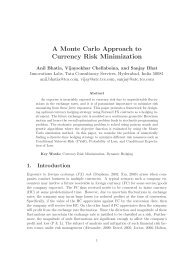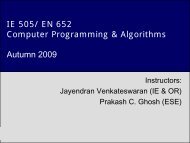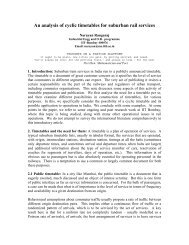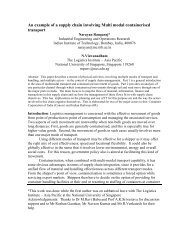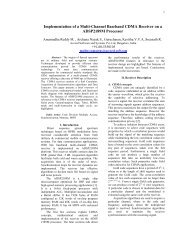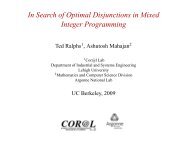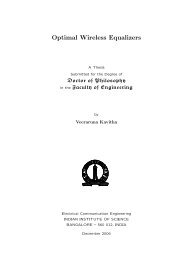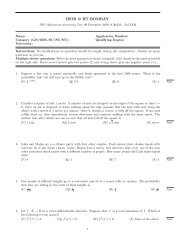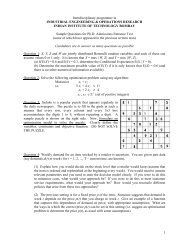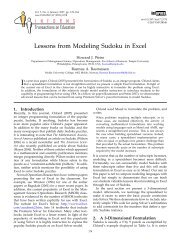Opportunistic Scheduling in Cellular Systems in the Presence of ...
Opportunistic Scheduling in Cellular Systems in the Presence of ...
Opportunistic Scheduling in Cellular Systems in the Presence of ...
Create successful ePaper yourself
Turn your PDF publications into a flip-book with our unique Google optimized e-Paper software.
1766 IEEE TRANSACTIONS ON INFORMATION THEORY, VOL. 58, NO. 3, MARCH 2012<br />
A. Motivat<strong>in</strong>g Example Cont<strong>in</strong>ued<br />
We first return to <strong>the</strong> motivat<strong>in</strong>g example <strong>of</strong> Section II to describe<br />
<strong>the</strong> ma<strong>in</strong> ideas.<br />
Optimal Policy for Mobile 2: The mobile uses <strong>the</strong> policy<br />
described as follows. It declares to be <strong>in</strong> state yield<strong>in</strong>g utility<br />
10 when <strong>in</strong> <strong>the</strong> same state, i.e., and <strong>in</strong> addition<br />
declares with probability to be <strong>in</strong> whenever <strong>in</strong> state ,<br />
i.e., . F<strong>in</strong>ally .<br />
Choose such that <strong>the</strong> best response <strong>of</strong> BS to this policy is to<br />
allocate to mobile 2 whenever state is declared. For this to<br />
hold, should be such that <strong>the</strong> utility <strong>of</strong> <strong>the</strong> BS is at least<br />
obta<strong>in</strong>ed by always allocat<strong>in</strong>g to <strong>the</strong> cooperative mobile 1. For<br />
such , <strong>the</strong> utility <strong>of</strong> BS and mobile 2 are given by<br />
and<br />
The that maximizes <strong>the</strong> utility <strong>of</strong> mobile 2 and yet keeps <strong>the</strong> BS<br />
utility above (i.e., which satisfies constra<strong>in</strong>t )<br />
is . The probability that mobile 2 declares that its channel<br />
is <strong>in</strong> state is . Thus with <strong>the</strong> above<br />
policy for mobile 2, BS’s best response among <strong>the</strong> simple<br />
policies is to select mobile 2 whenever it declares a . Denote<br />
it by . The couple is not an equilibrium because mobile<br />
2’s best response aga<strong>in</strong>st is simply to declare always.<br />
Thus <strong>the</strong> BS should allocate channel to mobile 2 upon hear<strong>in</strong>g<br />
<strong>the</strong> signal , only if it is guaranteed a utility <strong>of</strong> 8 or more. This<br />
can be done <strong>in</strong> a way similar to that <strong>in</strong> Section IV-B by allocat<strong>in</strong>g<br />
<strong>the</strong> channel to mobile 2 after fur<strong>the</strong>r verify<strong>in</strong>g that <strong>the</strong> mobile<br />
2 declares to be <strong>in</strong> for not more than <strong>of</strong> time. More precisely,<br />
<strong>the</strong> BS chooses <strong>the</strong> follow<strong>in</strong>g “signal predictive” policy 2<br />
: whenever mobile 2 declares allocate channel to mobile 2<br />
with probability where<br />
Fig. 4. Inf<strong>in</strong>itely many NE. The utility <strong>of</strong> <strong>the</strong> BS, mobile 1, and mobile 2 at<br />
equilibrium as function <strong>of</strong> .<br />
B. Ma<strong>in</strong> Result : A Generalization<br />
In this subsection we generalize <strong>the</strong> example <strong>of</strong> <strong>the</strong> previous<br />
subsection to an arbitrary number <strong>of</strong> players and states. We<br />
assume that signal statistics <strong>of</strong> all <strong>the</strong> mobiles is known<br />
to <strong>the</strong> BS. Hence <strong>the</strong> BS’s policy is given by as <strong>in</strong><br />
Section IV-B.<br />
Let<br />
represent <strong>the</strong> conditional expectation <strong>of</strong><br />
<strong>the</strong> mobile’s utility conditioned on <strong>the</strong> signal when mobile<br />
uses strategy , i.e., for every<br />
With represent<strong>in</strong>g <strong>the</strong> expectation w.r.t. , <strong>the</strong> pay<strong>of</strong>f for<br />
mobile is<br />
(27)<br />
One can verify that is an equilibrium that guarantees a<br />
rate <strong>of</strong> (respectively, ) to mobile 2 (respectively, 1) and<br />
a rate <strong>of</strong> 8 to <strong>the</strong> BS.<br />
Inf<strong>in</strong>itely Many Equilibria <strong>in</strong> Feedback Policies: In <strong>the</strong> sequel,<br />
we show that <strong>the</strong>re exists a cont<strong>in</strong>uum <strong>of</strong> NE where <strong>the</strong> BS<br />
gets a utility greater than 8. We use <strong>the</strong> same type <strong>of</strong> policy<br />
for mobile 2, but we choose . Then <strong>the</strong> probability that<br />
mobile 2 declares that it is <strong>in</strong> state 10 is .<br />
Consider <strong>the</strong> BS policy : BS selects mobile 2 with probability<br />
whenever <strong>the</strong> mobile declares that it <strong>in</strong> state where<br />
Thus <strong>the</strong> utilities <strong>of</strong> BS and mobile 2 are<br />
and<br />
, respectively. It is easy to show that <strong>the</strong> couple<br />
is a NE for each . In Fig. 4, we plot <strong>the</strong> utility<br />
<strong>of</strong> BS, mobile 1 and mobile 2 at equilibrium as function <strong>of</strong> .<br />
Given a signal probability -tuple , let (or more appropriately<br />
) represent what we shall call best mobile strategy<br />
that satisfies<br />
for every<br />
and for all<br />
Construction <strong>of</strong> : Consider mobile 1 without loss <strong>of</strong> generality.<br />
Let<br />
and assume<br />
. In <strong>the</strong> follow<strong>in</strong>g few l<strong>in</strong>es we omit subscript<br />
1 to improve readability, i.e., , etc. are represented<br />
by , , etc. Strategy is def<strong>in</strong>ed <strong>in</strong> a iterative way as follows.<br />
We first def<strong>in</strong>e<br />
, i.e., <strong>the</strong> conditional<br />
probability that mobile 1 declares that it is <strong>in</strong> its best state<br />
when it is actually <strong>in</strong> state . F<strong>in</strong>d <strong>the</strong> m<strong>in</strong>imum <strong>in</strong>dex<br />
such that <strong>the</strong> probability that <strong>the</strong> channel is <strong>in</strong> one <strong>of</strong> <strong>the</strong> top<br />
states is greater than or equal to , i.e., let<br />
2 This policy knows a priori <strong>the</strong> signal probabilities <strong>of</strong> mobile 2 and uses it for<br />
decision mak<strong>in</strong>g.



